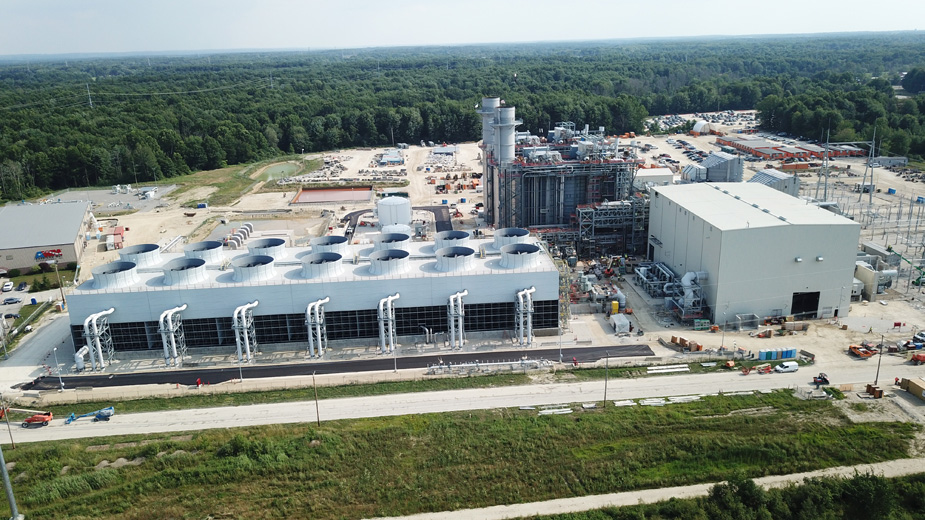Lordstown Energy Center Is Model for Future Power Plants
LORDSTOWN, Ohio — The sprawling power plant along Henn Parkway in Lordstown that took two years and hundreds of tradesmen to complete is among the most technologically sophisticated electrical-generation plants of its kind, says the facility’s new manager.
“Just about everything is automated,” said Drew Schneider, plant manager of the Lordstown Energy Center. “These are pretty significant systems that control everything.”
Officials announced Oct. 9 that the Lordstown Energy Center, a 940-megawatt natural gas-fueled power generation plant that broke ground in October 2016 had started operations. The $900 million plant is the fourth such combined-cycle power plant that produces 475 megawatts or more to be commissioned in Ohio, and the second in this region.
In January, Carroll County Energy, just south of Columbiana County, announced it had started operations. Two other plants, the Middletown Energy Center just north of Cincinnati and the Oregon Energy Center in Lucas County near Toledo had previously commissioned plants.
A third regional plant, the $1.3 billion South Field Energy plant near Wellsville in Columbiana County, recently kicked off construction. That project is expected to use about 1,000 tradesmen during the building phase.
In all, nearly $9.3 billion in new investment is slated for Ohio related to the development of these new plants, along with a projected 7,200 construction jobs, according to a report released this week by Energy In Depth. In all, more than $25 billion worth of investment in new energy plants are targeted for the entire Appalachian Basin, which includes Ohio, Pennsylvania and West Virginia.
“We began commercial operations Oct. 4,” Schneider said, noting the “first fire” of the plant occurred July 13 and 14, in which systems were tested and additional preparation work was performed.
A control room outfitted with about 20 screens monitors the entire plant’s operations, Schneider said. Data such as emissions, temperature, pressure levels and start/stop functions are all part of the operation.
In addition, outside maintenance technicians – that is, those that physically address and monitor equipment issues outside of the control room – are also on the floor assessing plant performance. “They’re the eyes and the ears of the operation,” Schneider said.
The plant will staff a full-time workforce of 21, he said. These positions consist of operators, managers, mechanics, administration and warehousing employees. On evening shifts, the plant anticipates having two staff on duty.
Yet Schneider said the system is set up so he can access and monitor the plant’s operations at any given time. “I can simply go into an application on my phone and look,” he said.
What makes the Lordstown plant technically superior to traditional coal-fired power generation plants is its combined use of natural gas and steam-powered turbines used to generate electricity, Schneider said. The equipment, manufactured by Siemens, consists of two natural gas-fired turbines and a single steam-powered turbine.
The heat exhaust from the two natural gas turbines is transferred to a heat recovery steam generator – a pressure boiler that forces steam into the third turbine, he explains. Excess steam is condensed into water, which is reheated again and converted into steam for reuse in the process.
Moreover, natural gas is a less expensive and cleaner fuel stock compared to coal, Schneider said. In the end, electrical generation is far more efficient as measured by the heat rate, that is, the amount of energy used by a power plant to generate one kilowatt hour of electricity. Standard coal plants on average use between 8,000 and 12,000 British thermal units, or Btu, to produce a single kilowatt hour. The Lordstown plant, he said, uses around 6,500 Btu.
That’s an improvement from when Schneider started his career in the industry 17 years ago. Then, he says natural gas plants averaged 7,200 Btu to produce a kilowatt of electricity.
Natural gas reserves in the Utica and Marcellus shale in eastern Ohio and western Pennsylvania also assures a long-term supply of the fuel, which can be easily piped in from processing plants or transmission lines, instead of being hauled in by truck or rail, Schneider says.
“The amount of time it takes to start up a plant has also improved,” Schneider said. When he started in the business, it wasn’t unusual for it to take up to an hour and 20 minutes before a plant reached full load. “Now, we can be at full load in less than half an hour and additional improvements we have planned for here will make it even better.”
Lordstown Energy Center is capable of supplying enough energy to power 850,000 homes.
The developer of the Lordstown Energy Center, Clean Energy Future LLC of Boston, sold the majority of the project to Macquarie Group, an international investment firm, which owns 70% of the plant. Siemens has a 25% stake in the project, while Clean Energy holds a 5% share in the venture.
Plans for Clean Energy Future to build a second power plant similar in scope, the Trumbull Energy Center, next to the Lordstown plant are on hold because of ongoing litigation that at press time had not been resolved.
That project calls for another investment of about $900 million and the creation of 900 construction jobs.
Copyright 2024 The Business Journal, Youngstown, Ohio.



